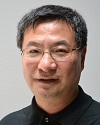MT5GNet 21 May 2017 (Full day)
Technical Program
Sunday 21 May 2017 Paris, France
| Time | Duration | Title |
|---|---|---|
| 9:00 - 9:45 | 45 |
Keynote 1: Eric Hardouin (Orange Labs) |
| 9:45 - 10:30 | 45 |
Session 1: Operators & 5G networks |
| 10:30 - 11:00 | 30 | Pause |
| 11:00 - 11:45 | 45 |
Keynote 2: Merouane Debbah (Huawei) |
| 11:45 - 12:30 | 45 |
Session 2: MIMO channel for 5G networks |
| 12:30 - 14:00 | 01:30 | Lunch |
| 14:00 - 14:45 | 45 |
Keynote 3: Geng Wu (Intel) |
| 14:45 - 15:30 | 45 |
Session 3: Modulation trends in 5G networks |
| 15:30 - 16:00 | 30 | Pause |
| 16:00 - 17:30 | 01:30 |
Session 4: Reshaping networks for 5G |
Keynote Speakers
Title: Towards 5G real world deployments
Eric Hardouin, Director Ambient Connectivity research domain, Orange Labs, France
 Dr. Eric Hardouin is the director of the “Ambient Connectivity” research domain of Orange Labs, which investigates future access and transport networks and technologies, as well as related business models. Eric received his Ph.D. degree in signal processing and telecommunications from Telecom Bretagne and the University of Rennes 1, France, in 2004. Since 2004, he has been with Orange Labs, where he has conducted or supervised research on interference mitigation for mobile networks. Between 2008 and 2013 he represented Orange in the physical layer standardization group of 3GPP (RAN WG1) for HSPA, LTE and LTE-Advanced. From 2012 to 2015, Eric coordinated the research on wireless networks in Orange Labs. Eric had a leading role in the NGMN 5G White Paper, as co-lead of the work on 5G requirements. Eric is the author of the book “LTE et les réseaux 4G” (in French).
Dr. Eric Hardouin is the director of the “Ambient Connectivity” research domain of Orange Labs, which investigates future access and transport networks and technologies, as well as related business models. Eric received his Ph.D. degree in signal processing and telecommunications from Telecom Bretagne and the University of Rennes 1, France, in 2004. Since 2004, he has been with Orange Labs, where he has conducted or supervised research on interference mitigation for mobile networks. Between 2008 and 2013 he represented Orange in the physical layer standardization group of 3GPP (RAN WG1) for HSPA, LTE and LTE-Advanced. From 2012 to 2015, Eric coordinated the research on wireless networks in Orange Labs. Eric had a leading role in the NGMN 5G White Paper, as co-lead of the work on 5G requirements. Eric is the author of the book “LTE et les réseaux 4G” (in French).
 Dr. Eric Hardouin is the director of the “Ambient Connectivity” research domain of Orange Labs, which investigates future access and transport networks and technologies, as well as related business models. Eric received his Ph.D. degree in signal processing and telecommunications from Telecom Bretagne and the University of Rennes 1, France, in 2004. Since 2004, he has been with Orange Labs, where he has conducted or supervised research on interference mitigation for mobile networks. Between 2008 and 2013 he represented Orange in the physical layer standardization group of 3GPP (RAN WG1) for HSPA, LTE and LTE-Advanced. From 2012 to 2015, Eric coordinated the research on wireless networks in Orange Labs. Eric had a leading role in the NGMN 5G White Paper, as co-lead of the work on 5G requirements. Eric is the author of the book “LTE et les réseaux 4G” (in French).
Dr. Eric Hardouin is the director of the “Ambient Connectivity” research domain of Orange Labs, which investigates future access and transport networks and technologies, as well as related business models. Eric received his Ph.D. degree in signal processing and telecommunications from Telecom Bretagne and the University of Rennes 1, France, in 2004. Since 2004, he has been with Orange Labs, where he has conducted or supervised research on interference mitigation for mobile networks. Between 2008 and 2013 he represented Orange in the physical layer standardization group of 3GPP (RAN WG1) for HSPA, LTE and LTE-Advanced. From 2012 to 2015, Eric coordinated the research on wireless networks in Orange Labs. Eric had a leading role in the NGMN 5G White Paper, as co-lead of the work on 5G requirements. Eric is the author of the book “LTE et les réseaux 4G” (in French).
Abstract: While 5G standardization is ongoing and trial initiatives are developing, this talk will provide an up-to-date operator vision on the expectations from 5G. We will review the expected services, key techniques and their impact on practical network deployments. We will discuss the steps to be taken from now to commercial deployments, and will provide an overview of the ongoing collaborative initiatives preparing 5G we are involved with. Finally, we will discuss open research questions related to 5G.
5G: from research to standardization
Mérouane Debbah, Vice-president, Huawei, FRC, France

Mérouane Debbah entered the Ecole Normale Supérieure de Cachan (France) in 1996 where he received his M.Sc and Ph.D. degrees respectively. He worked for Motorola Labs (Saclay, France) from 1999-2002 and the Vienna Research Center for Telecommunications (Vienna, Austria) until 2003. From 2003 to 2007, he joined the Mobile Communications department of the Institut Eurecom (Sophia Antipolis, France) as an Assistant Professor. Since 2007, he is a Full Professor at CentraleSupelec (Gif-sur-Yvette, France). From 2007 to 2014, he was the director of the Alcatel-Lucent Chair on Flexible Radio. Since 2014, he is Vice-President of the Huawei France R&D center and director of the Mathematical and Algorithmic Sciences Lab. His research interests lie in fundamental mathematics, algorithms, statistics, information & communication sciences research. He is an Associate Editor in Chief of the journal Random Matrix: Theory and Applications and was an associate and senior area editor for IEEE Transactions on Signal Processing respectively in 2011-2013 and 2013-2014. Mérouane Debbah is a recipient of the ERC grant MORE (Advanced Mathematical Tools for Complex Network Engineering). He is a IEEE Fellow, a WWRF Fellow and a member of the academic senate of Paris-Saclay. He has managed 8 EU projects and more than 24 national and international projects. He received 17 best paper awards, among which the 2007 IEEE GLOBECOM best paper award, the Wi-Opt 2009 best paper award, the 2010 Newcom++ best paper award, the WUN CogCom Best Paper 2012 and 2013 Award, the 2014 WCNC best paper award, the 2015 ICC best paper award, the 2015 IEEE Communications Society Leonard G. Abraham Prize, the 2015 IEEE Communications Society Fred W. Ellersick Prize, the 2016 IEEE Communications Society Best Tutorial paper award, the 2016 European Wireless Best Paper Award and the 2017 Eurasip Best Paper Award as well as the Valuetools 2007, Valuetools 2008, CrownCom2009, Valuetools 2012 and SAM 2014 best student paper awards. He is the recipient of the Mario Boella award in 2005, the IEEE Glavieux Prize Award in 2011 and the Qualcomm Innovation Prize Award in 2012.
Abstract: If we look at some of the goals of 5G versus where we are today, we can see the gap that has to be bridged over the next few years. The goal of 1ms latency is nearly 50x better than current LTE systems. In order to go from 100Mbps per user to 10Gbps, we need 100x the throughput per connection. The current 10,000 connections per square kilometer needs to increase to 1Million connections, which corresponds to 100x increase in density. Reliable communications today with LTE top out about 350km/h and we expect to bring that up by 1.5x to 500km/h. Finally, the current core networks and backhaul/fronthaul are inflexible with wasted pools of bandwidth. The introduction of SDN/NFV will allow much better ability to chop up and virtualize the network resources for lower operational costs and capital costs and much greater flexibility. In this talk, we will give an update on standardization process and the challenges ahead for a true deployment by 2020.
What is next for 5G?
Geng Wu, Intel Fellow


Dr. Geng Wu is the chief technologist for wireless standards and advanced technology at Intel Corporation, and an Intel Fellow. He leads Intel's fifth-generation (5G) wireless standards and technology development, works extensively with global research community and ecosystem partners. Dr. Wu’s current research interests include 5G mobile computing and communication platforms, future generation network architectures and devices, mmWave channel modeling, new air interface design and performance evaluation, and cross-layer optimization for future mobile services and applications.
Abstract: This talk will focus on the key technology trends in communication and computing to support new types of devices, new types of frequency bands, evolved network architectures for machine-type application scenarios, new types of connectivity solutions, and future tight integration of computing and communications through virtualization technologies.
Detailed Program
Sunday 21 May 2017 Paris, France
| Paper | Authors |
| Fairness in Future Licensed Assisted Access (LAA) LTE Networks: What Happens When Operators Have Different Channel Access Priorities? |
Abdel-karim Ajami; Hassan A. Artail |
| Inter-Operator Infrastructure Sharing: Trade-offs and Market |
Tachporn Sanguanpuak; Sudarshan Guruacharya; Ekram Hossain; Matti Latva-aho |
| Delay Minimization in Dynamic and Scalable Multi-operator Wireless Backhauling |
Dídac Surís; Josep Vidal; Adrian Agustin |
| Paper | Authors |
| An Enhanced Tomlinson-Harashima Precoding Scheme for High-order MU-MIMO Transmissions in 5G Networks |
Xin Wang; Xiaolin Hou; Huiling Jiang; Lan Chen |
| Enhanced Time-shifted Pilot based Channel Estimation in Massive MIMO Systems with Finite Number of Antennas |
Liang Wu; Zaichen Zhang; Jian Dang; Huaping Liu |
| Indoor Office Wideband Penetration Loss Measurements at 73 GHz |
Jacqueline Ryan; George R MacCartney, Jr.; Theodore Rappaport |
| Paper | Authors |
| 5G Wireless and Wired Convergence in a Passive Optical Network using UF-OFDM and GFDM |
Colm Browning; Arman Farhang; Arsalan Saljoghei; Nicola Marchetti; Vidak Vujicic; Linda Doyle; Liam Barry |
| WOLA processing: a useful tool for windowed waveforms in 5G with relaxed synchronicity |
Yahia Medjahdi; Rafik Zayani; Hmaied Shaiek; Daniel Roviras |
| On Energy Efficiency Optimization in Downlink MIMO-NOMA |
Pan Wu; Jie Zeng and Xin Su; Hui Gao; Tiejun Lv |
| Paper | Authors |
| Consistent-Estimated Eigenvalues Based Cooperative Spectrum Sensing for Dense Cognitive Small Cell Network |
Meng Zhao; Caili Guo; Chunyan Feng; Shuo Chen |
| A Two-level Auction for C-RAN Resource Allocation |
Mira Morcos; Tijani Chahed; Lin Chen; Jocelyne Elias; Fabio Martignon |
| On the Performance of Directional Communications in Ultra-Dense Networks |
Arvind Merwaday; Rath Vannithamby; Mohammad Mamunur Rashid; Yi Zhang; Clark Chen; Xiaoyun WU |
| Novel Concept of D2D Mobility Modeling utilizing Biological Cell Jamming/Unjamming Paradigm |
Subharthi Banerjee; Michael Hempel; Hamid Sharif |
| Ultra-Reliable PPDR Broadcast using Licensed Simultaneously Shared Access Networks |
Vinay Gupta; Aditya Pradeep; Krishna M; Muthulakshmi C; Kaushik C; C R Venkatesh; K Giridhar |